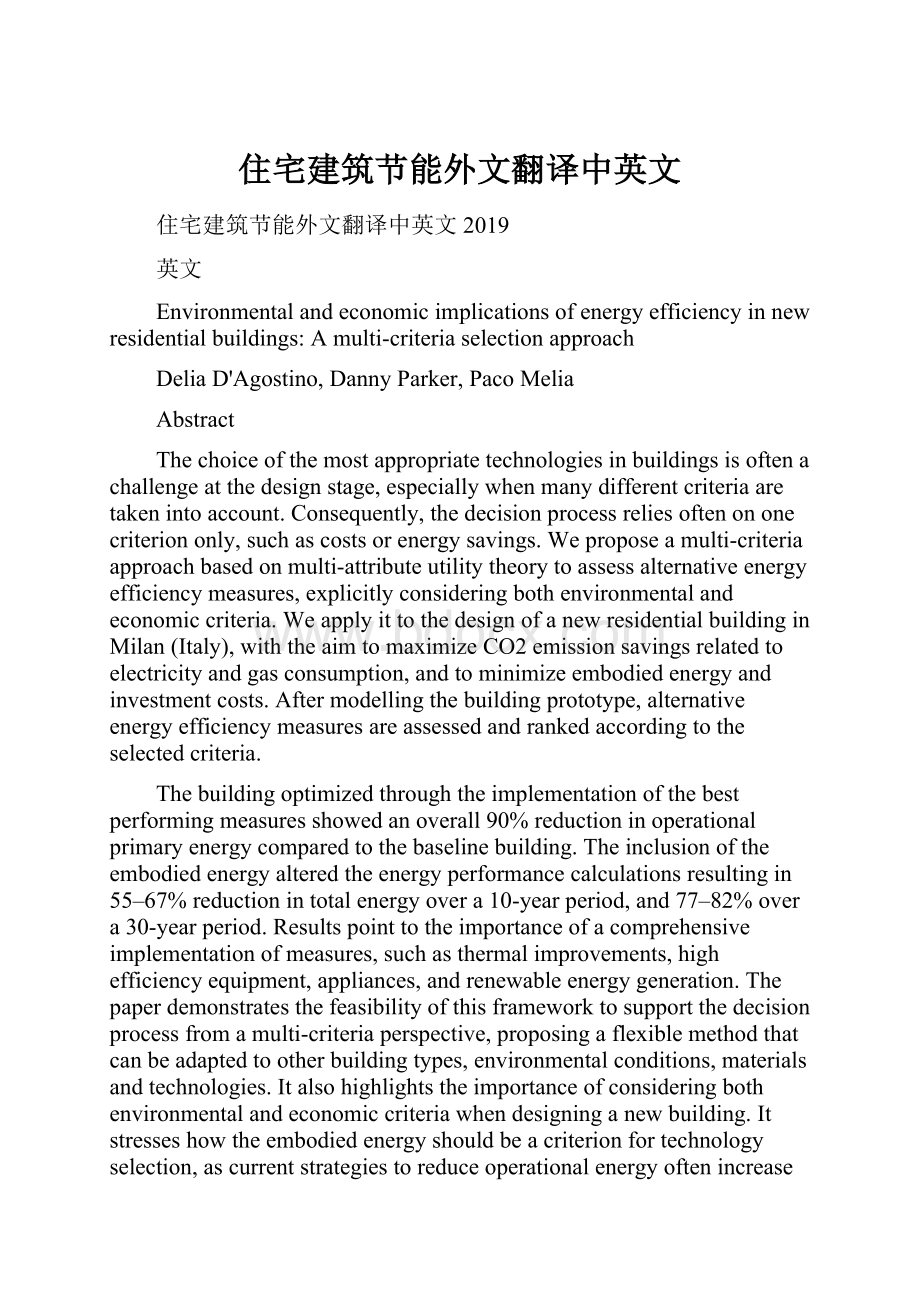住宅建筑节能外文翻译中英文.docx
《住宅建筑节能外文翻译中英文.docx》由会员分享,可在线阅读,更多相关《住宅建筑节能外文翻译中英文.docx(16页珍藏版)》请在冰豆网上搜索。

住宅建筑节能外文翻译中英文
住宅建筑节能外文翻译中英文2019
英文
Environmentalandeconomicimplicationsofenergyefficiencyinnewresidentialbuildings:
Amulti-criteriaselectionapproach
DeliaD'Agostino,DannyParker,PacoMelia
Abstract
Thechoiceofthemostappropriatetechnologiesinbuildingsisoftenachallengeatthedesignstage,especiallywhenmanydifferentcriteriaaretakenintoaccount.Consequently,thedecisionprocessreliesoftenononecriteriononly,suchascostsorenergysavings.Weproposeamulti-criteriaapproachbasedonmulti-attributeutilitytheorytoassessalternativeenergyefficiencymeasures,explicitlyconsideringbothenvironmentalandeconomiccriteria.WeapplyittothedesignofanewresidentialbuildinginMilan(Italy),withtheaimtomaximizeCO2 emissionsavingsrelatedtoelectricityandgasconsumption,andtominimizeembodiedenergyandinvestmentcosts.Aftermodellingthebuildingprototype,alternativeenergyefficiencymeasuresareassessedandrankedaccordingtotheselectedcriteria.
Thebuildingoptimizedthroughtheimplementationofthebestperformingmeasuresshowedanoverall90%reductioninoperationalprimaryenergycomparedtothebaselinebuilding.Theinclusionoftheembodiedenergyalteredtheenergyperformancecalculationsresultingin55–67%reductionintotalenergyovera10-yearperiod,and77–82%overa30-yearperiod.Resultspointtotheimportanceofacomprehensiveimplementationofmeasures,suchasthermalimprovements,highefficiencyequipment,appliances,andrenewableenergygeneration.Thepaperdemonstratesthefeasibilityofthisframeworktosupportthedecisionprocessfromamulti-criteriaperspective,proposingaflexiblemethodthatcanbeadaptedtootherbuildingtypes,environmentalconditions,materialsandtechnologies.Italsohighlightstheimportanceofconsideringbothenvironmentalandeconomiccriteriawhendesigninganewbuilding.Itstresseshowtheembodiedenergyshouldbeacriterionfortechnologyselection,ascurrentstrategiestoreduceoperationalenergyoftenincreasetheamountofenergyembodiedintobuildingswithenvironmentalconsequences.
Keywords:
Multi-criteriadecisionmaking,Energyefficiencymeasures,Embodiedenergy,Multi-attributeutilitytheory(MAUT),Buildingmodellingandsimulation,CO2emissionsavings
Introduction
EnergyefficiencyisrecognizedasoneoftheprioritiesoftheEnergyUnionstrategy.Improvingenergyefficiencyisexpectedtoreducegreenhousegas(GHG)emissionsandenergyimportdependency,createjobs,boostenergysecurity,supportresearch,innovationandcompetitiveness.Accountingforapproximately40%ofprimaryenergyand36%ofgreenhouseemissions,thebuildingsectoriscurrentlythelargestend-usesectorinEurope.Inparticular,theresidentialsectorconsumesmorethanaquarteroftotalenergyandaccountsfortwothirdsofbuildingconsumption.
TheEuropeanUnionhaslaunchedapolicyframeworkaimedatreducingenergyconsumptionandobtainingconsiderablesavingsfrombuildings.TheEnergyEfficiencyDirective(EED)andtheRenewableEnergyDirective(RED)containimportantprovisions,butamajorstepforwardisrepresentedbytheEnergyPerformanceofBuildingsDirectiverecast.TheDirectiveestablishestheimplementationofnearlyzeroenergybuildings(NZEBs)asthebuildingtargetfrom2018onwards.NZEBsaredefinedasbuildingswithaveryhighenergyperformance,whereenergyrequirementsshouldmostlybecoveredbyrenewableenergysources.Anotherimportantnoveltyistheintroductionofcost-optimality.Amethodologyisdescribedtoderivecost-optimallevelsofminimumenergyperformancerequirements.Thecost-optimallevelrepresentstheenergyperformancewhichleadstothelowestcostoverthebuildinglifecycle.
CombiningNZEBsandcost-optimalityremainschallengingandoftenperformedonlyataresearchlevel.Additionally,althoughdifferentstudieshavehighlightedthatreachingtheNZEBstargetisachievable,itisnotalwaysproventhattheselecteddesignchoicesarethemostsuitablefrombothanenvironmentalandeconomicperspective.
Moreover,improvingenergyefficiencyinbuildingshasbeenmainlyfocusedonreducingoperationalemissions(e.g.linkedtoheating,ventilation,airconditioningsystems(HVAC),domestichotwater,lighting,appliances),butitisestimatedthatabout30%oftheenergyconsumedthroughoutthelifetimeofabuildingiswithinitsembodiedenergy.
Researchaims
Thisstudyaimsatillustratingamethodabletoselectthetechnologymeasuresthataremostconvenientfromaneconomicandenvironmentalperspective.AnewresidentialbuildinglocatedinMilan(Italy)ischosenasacasestudy.Anassessmentapproachbasedonmulti-attributeutilitytheory(MAUT)hasbeendevelopedtosupportamulti-criteriaevaluationofselectedtechnologymeasures.Thestudyconsidersatthesametimetheminimizationofembodiedenergyandinvestmentcosts,aswellasthemaximizationofelectricityandgassavingsassociatedwitheachmeasure.Theproposedapproachallowsacomparisonofalternativetechnologiestobepotentiallyimplementedinthebuildingprototype.Theresearchinvolvesthefollowingsteps:
•identificationofappropriatecriteriarepresentingthedifferentobjectivesofthedecisionandtheirorganizationintoahierarchy;
•establishmentofmathematicalfunctionstoevaluatethesatisfaction(utility)associatedwitheachalternativewithrespecttodifferentcriteria;
•determinationofasetofweightsthatrepresenttherelativeimportanceofeachcriteriontotheoverallutility;
•evaluationandrankingofthealternatives.
Thebaselineandtheoptimizedbuildingarethensimulatedandcomparedintermsofenergyconsumption,costsandCO2 emissions.Finally,asensitivityanalysisisperformedtoassesshowtheoutputsareaffectedbytheuncertaintyontherelativeimportanceoftheselectedcriteriaaswellasembodiedenergyestimations.
Literaturereview
Aliteraturereviewisnowgiveninrelationtothemaintopicslinkedtothispaper:
embodiedenergy,technologymeasures,andmulti-criteriadecision-makingmethods.
Embodiedenergy
Althoughlargelyignored,theembodiedenergycomprisesthematerialsusedinthebuildingandtechnicalinstallations,aswellastheenergyconsumedatthetimeofconstructionorrenovationofthebuilding.Inparticular,itincludes:
theenergyusedtoextractrawresources,processmaterials,assembleproductcomponents,transportbetweeneachstep,construction,maintenanceandrepair,deconstructionanddisposal.Theestimatedembodiedenergydependsonfactorssuchasbuildingage,climate,andmaterials.
Thebuildingenvelopeisakeyelementforbothembodiedandoperationalenergyinbuildings.Inmoredetail,thebuildingenvelope(floors,walls,roof,andfinishes)contributesforabout48–50%totheoverallembodiedenergyofastandardhouse.Althoughenvelopeimprovementscontributetoloweroperationalenergyconsumption,thereareconcernsabouttheglobalwarmingpotentialandotherimpactsthatsometechnologiescanhaveontheenvironment.
EmbodiedenergyandcostsofrecycledandreusedmaterialswidelyvaryRecentliteratureemphasizesstandardprotocolsfortheestimationofembodiedenergy.Althoughtherearestandards,suchasEN15978andsubsequentstandards,questionsonembodiedenergyquantificationremain.Forinstance,thereisextensiveuncertaintyregardingtheembodiedenergyevaluation,mainlylinkedtoavailabledatasources,estimationmethodologies,variabilityoftimeandlocation.
Bothoperationalenergyandembodiedenergyaresubjecttoperformancegaps.Thegapcanbebetweensimulatedandmonitoreddatainrelationtotheoperationalenergy.Itissubjecttomeasurementboundariesandempiricaldatasourcesforembodiedenergydata.Relativetobuildingsimulation,therehavefrequentlybeenperformancegapswheresavingsfromsimulationhavebeenhigherthanthatrealizedinrealbuildings.However,therearemanyeffortstoaddresstheseshortcomingsthroughtheuseofrealmonitoreddatatoguideandvalidatesimulationinputs.
ThemostcommonlyusedmeanstoestimateembodiedenergyformaterialsorproductsistheLifeCycleAssessment(LCA)framework.Thisisastandardizedenvironmentaltooltoquantifytheenergy,carbonorwaterliabilitieswhichaproductorprocessimposesonthephysicalenvironment.Thisisusuallycarriedoutaslife-cycleenergyassessment,aformofLCAwhereenergyconsumptionofthevariousphasesismeasuredtoaccountforallenergyinputsoverthebuildinglife.Differencesinembodiedenergyfactorsariseinembodiedenergyestimationsduetodifferencesinscopeaswellasinthetechnologyusedformaterialproductionandtransportation.
Besidestheembodiedenergy,itisworthmentioningtheembodiedcarbonwhichconsidershowGHGsarereleasedthroughoutthesupplychaintoprovideamaterialorservice.Itrepresentsthecarbonfootprintofamaterialorprocess.Itisanalternativemetricwhichcanbemorecomprehensiveinaccountingfortheemissionsintensityoftheenergycarrier.
Todate,anumberofstudiesconsidertheembodiedcarbonorembodiedenergyasacriteriafortechnologyselectionalongwithenergysavingsandcostsinlowenergybuildings.Inparticular,Thormarkandothershaveshownthatverylowenergybuildingstypicallyhaveembodiedenergiesthataremuchhigherthanconventionalstructures.Theadditionalembodiedenergymustberecapturedbysuccessfulreductionsinoperationalenergy.AsbuildingsbecomemoreefficientorapproachNZEBs,embodiedenergycanbecomemorethanhalfthetotalbuildingenergyoveritsusefullife.FortheevaluationofaPassiveHousedesign,embodiedenergyhasbeenfoundtobesohightha